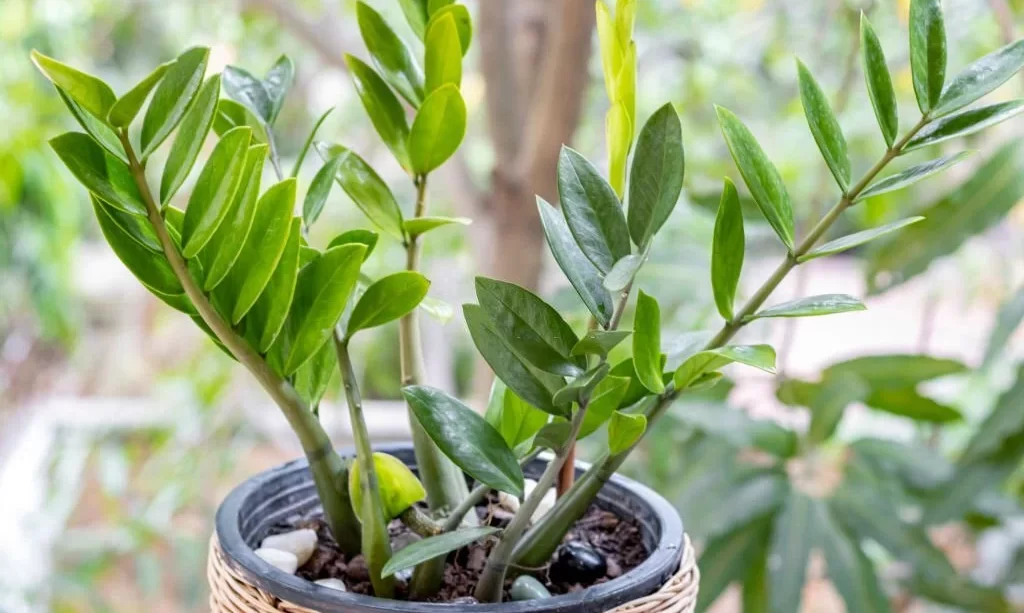ZZ plants, scientifically known as Zamioculcas zamiifolia, have long been cherished as popular indoor houseplants. These hardy and low-maintenance green beauties have graced countless homes and offices, earning a reputation for their ability to thrive even in less-than-ideal indoor conditions. Yet, as plant enthusiasts often wonder, can these beloved indoor companions find success in the great outdoors? In this comprehensive guide, we embark on a journey to explore the possibility of ZZ plants flourishing outdoors, shedding light on the factors to consider, the potential benefits, and the essential care guidelines for such a transition.
ZZ Plant Basics
To grasp the prospects and challenges of placing a ZZ plant outdoors, it’s essential to start with a foundational understanding of these iconic indoor plants. Zamioculcas zamiifolia, native to Eastern Africa, has evolved to thrive in specific conditions, which are often different from the outdoor environments many of us experience. Key points to consider include:
- Tropical Origins: ZZ plants hail from regions with warm temperatures, low humidity, and filtered, indirect sunlight. Their native habitat offers valuable insights into their ideal growing conditions.
- Indoor Adaptation: Over time, ZZ plants have adapted to indoor environments, becoming popular houseplants. They have grown accustomed to the stable temperature and humidity levels found in homes.
- Resilience: ZZ plants are known for their resilience and ability to withstand neglect. They are often chosen for their ability to thrive in low-light conditions and infrequent watering.
The Potential Benefits of Outdoor Living
The allure of moving a ZZ plant outdoors lies in the potential benefits that outdoor living can offer to these plants. While ZZ plants are celebrated for their adaptability indoors, outdoor placement may present several advantages:
- Increased Sunlight: Placing a ZZ plant outside can provide access to more abundant natural light, which can enhance the plant’s growth and contribute to its lush appearance.
- Improved Air Circulation: Outdoor environments naturally offer better air circulation, reducing the risk of stagnant, humid conditions that can lead to fungal issues indoors.
- Natural Humidity: ZZ plants can benefit from higher humidity levels, particularly in the early morning and late evening. Outdoor exposure may offer these natural humidity fluctuations, promoting overall health.
- Growth Stimulation: Exposure to outdoor elements, including gentle breezes and rainfall, can stimulate growth and contribute to a more vigorous, thriving plant.
While these potential benefits are enticing, it’s crucial to approach outdoor placement thoughtfully and with a keen understanding of the specific conditions in your area. This way, you can make an informed decision and provide the best possible care for your ZZ plant as it ventures into the great outdoors.
- 🌿 Zamioculcas Zen: Elevate your ZZ Plant care with Gardenera’s meticulously crafted Zamioculcas Potting Mix, a blend designed to create a harmonious environment for your plants to thrive.
- 🍃 Premium Blend for Optimal Growth: Our potting mix fuses Canadian Peat Moss, nutrient-rich Worm Castings, well-structured Sand, lightweight Perlite, and natural Charcoal, forming the perfect foundation for your ZZ Plant vitality.
- 💦 Moisture Balance Perfected: The interplay of Canadian Peat Moss and Sand maintains a delicate moisture balance, providing a nurturing space where your Zamioculcas’ roots can flourish, resulting in lush and vibrant foliage.
- 🌱 Organic Nutrient Infusion: The infusion of Worm Castings enriches the mix with organic nutrients, promoting robust growth, strong stems, and overall plant health.
- 🏞️ Sandy Soothing Habitat: Sand creates an environment reminiscent of arid landscapes, mirroring the natural setting where Zamioculcas thrive, supporting their natural growth pattern.
Assessing Outdoor Conditions
Before embarking on the journey of transitioning your ZZ plant outdoors, it’s vital to assess the outdoor conditions in your specific area. ZZ plants thrive in certain conditions, and your outdoor space should align with their needs:
- Climate Evaluation: Consider your local climate, including temperature ranges and weather patterns throughout the year. ZZ plants prefer consistently warm temperatures and are sensitive to cold drafts or frost. If your region experiences harsh winters or extreme temperature fluctuations, outdoor placement may not be suitable.
- Sunlight Analysis: Evaluate the amount and quality of sunlight in your outdoor space. ZZ plants are accustomed to bright, indirect light. Ensure that your chosen location offers filtered or dappled sunlight and protection from harsh, direct sun, especially during the hottest parts of the day.
- Temperature Considerations: ZZ plants are sensitive to temperature changes. Assess whether your outdoor area provides a stable, warm environment during the growing season. Be prepared to bring the plant indoors or provide protection during cold snaps or heatwaves.
- Protection from the Elements: Consider whether your outdoor space offers natural protection from strong winds, heavy rains, or other environmental stressors. ZZ plants can be vulnerable to strong winds, which can damage their leaves. Ensure they have some shelter or windbreaks if necessary.
Gradual Transitioning
The transition from indoor to outdoor living should be a gradual process to minimize shock and stress for your ZZ plant:
- Seasonal Timing: Spring is typically the best time to introduce your ZZ plant to outdoor conditions. This season provides milder temperatures and longer daylight hours, ideal for acclimation.
- Start Slowly: Begin by placing the plant outdoors for short periods, gradually increasing the exposure over several weeks. This allows the plant to adjust to changes in light, temperature, and humidity.
- Vigilant Monitoring: Throughout the transition, closely monitor your ZZ plant for signs of stress, such as leaf drooping or discoloration. If you notice any issues, consider reducing outdoor exposure and providing extra care, such as adjusting watering and humidity levels.
- WONDERFULLY ORGANIC – Contains premium organic ingredients made with your home and the environment in mind. Working with organics can make a big impact on your plant’s overall vigor. Perfect when paired with compost, worm castings, leaf shine spray, and other natural products.
- ESSENTIAL NUTRIENTS – Premium, urea free balanced mix of macro and micro nutrients that gently feeds all potted household plants. Super vitamin and bloom booster formula helps encourage strong roots, new growth, and beautiful leaves for sustainable long term plant vigor.
- TRULY ALL-PURPOSE – Excellent for both plant care and organic gardening. Use with all common houseplant types (indoor and outdoor) in various potting containers. Ideal to use on live plants around the entire house, apartment, and office.
- GROW WITH CONFIDENCE – Plant care made simple. Easy to understand instructions makes using our solution in watering cans or a spray bottle effortless. Just dilute with water, apply, and watch your plants thrive! Can be applied in a pot containing gravel, moss, pebbles, perlite, pumice, lava rocks, and other soil mixes.
- FOR POPULAR HOUSEPLANTS – Air plant, fiddle leaf fig, snake plant, orchids, bonsai trees, spider, string of pearls, monstera, pothos, zz, bamboo, peace lily, african violet, aloe vera, prayer, hoya, mums, ivy, elephant ear, palm, fern, pilea, philodenron, dracaena, chinese evergreen, succulents, cactus, jasmine, money tree, other hanging and trailing plants, terrarium plants, tropical plants and many more!
Protection from Environmental Stressors
Outdoor living can expose your ZZ plant to various environmental stressors. To ensure its well-being, take protective measures:
- Wind Protection: ZZ plants have delicate, glossy leaves that can be damaged by strong winds. Consider placing your plant in a sheltered location or using screens or windbreaks to shield it from gusty conditions.
- Rain Control: While ZZ plants benefit from occasional rain, excessive moisture can lead to root rot. Use well-draining soil and ensure that the plant’s pot has adequate drainage holes to prevent waterlogged roots. Move the plant under cover during heavy downpours.
- Pest Vigilance: Outdoor environments can attract more pests. Regularly inspect your ZZ plant for signs of pests like mealybugs or spider mites. If infestations occur, take prompt action to address them.
By carefully assessing outdoor conditions, transitioning gradually, and protecting your ZZ plant from environmental stressors, you can enhance its chances of thriving in its new outdoor environment. In the next paragraphs, we’ll delve into the monitoring and maintenance needed for an outdoor ZZ plant, potential challenges and risks, and when outdoor living may not be the best option.
Monitoring and Maintenance
Once your ZZ plant has successfully transitioned to outdoor living, ongoing monitoring and maintenance are crucial for its well-being:
- Watering: Outdoor conditions can affect your plant’s water needs. Monitor the soil’s moisture level and adjust your watering schedule accordingly. Ensure that you water thoroughly but avoid letting the plant sit in standing water, which can lead to root rot.
- Fertilization: ZZ plants benefit from regular fertilization during the growing season. Use a balanced, water-soluble fertilizer and follow the manufacturer’s instructions. Outdoor growth may demand additional nutrients due to increased sunlight and growth rate.
- Pruning: Trim any damaged or yellowing leaves to encourage healthy new growth and maintain the plant’s appearance. Pruning may be necessary to manage outdoor growth more vigorously than indoor growth.
- Pest Control: Continue to monitor for pests and take prompt action if you notice any infestations. Outdoor environments can attract more pests, so vigilance is key to keeping your ZZ plant healthy.
Potential Challenges and Risks
While outdoor placement can offer numerous benefits, it’s important to be aware of potential challenges and risks for ZZ plants:
- Temperature Extremes: Sudden temperature fluctuations or extreme heat can stress the plant. Be prepared to provide protection during such conditions to prevent damage.
- Pest Pressure: Outdoor environments may attract a variety of pests. Regularly inspect your plant and implement pest control measures as needed to ensure its health.
- Leaf Scorch: ZZ plants can be sensitive to intense, direct sunlight, leading to leaf scorch or discoloration. Ensure that your outdoor placement provides adequate shade and protection during the sunniest parts of the day.
- Root Rot: Frequent rainfall or overwatering can increase the risk of root rot. Use well-draining soil and pots with drainage holes to prevent waterlogged roots.
When Outdoor Living Isn’t Ideal
There are situations where outdoor placement may not be the best choice for your ZZ plant:
- Harsh Climates: In regions with extremely cold winters, hot summers, or unpredictable weather, ZZ plants may struggle to thrive outdoors.
- Limited Space: If you have limited outdoor space or live in an urban setting, finding an appropriate outdoor spot for your plant can be challenging.
- Indoor Preference: Some ZZ plants simply prefer the stable conditions of indoor living and may not adapt well to outdoor environments.
- Plant Health: If your ZZ plant has pre-existing health issues or is already stressed, transitioning it outdoors may exacerbate its condition.
Conclusion
In conclusion, the prospect of cultivating a ZZ plant outdoors offers exciting possibilities for enhanced growth and vitality. By carefully considering outdoor conditions, transitioning gradually, and providing diligent care, you can successfully introduce your indoor companion to the outdoor world.
However, it’s crucial to remain attentive to your plant’s needs and respond promptly to any challenges that may arise. Outdoor living can bring new life to your ZZ plant, but it also demands responsible stewardship.
As you embark on this botanical adventure, remember that each ZZ plant is unique. Pay attention to its responses and adapt your care accordingly. By doing so, you can enjoy the beauty and resilience of these remarkable plants, whether they grace your indoor spaces or thrive in the great outdoors.






